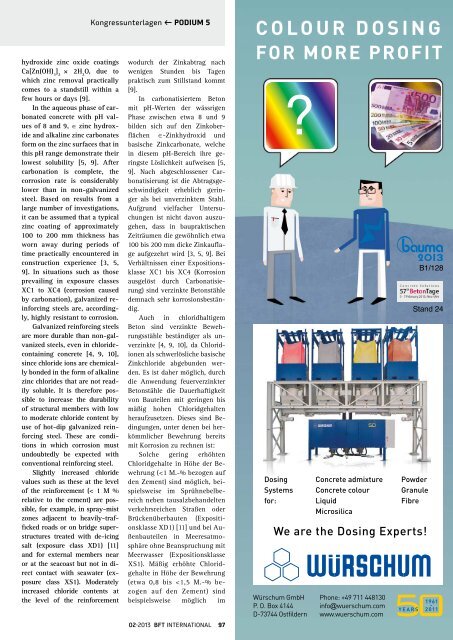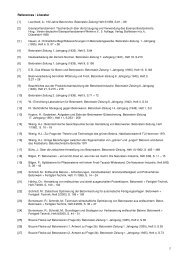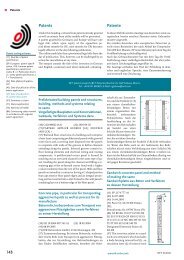KONGRESSUNTERLAGEN | PROCEEDINGS - Bft-international.com
KONGRESSUNTERLAGEN | PROCEEDINGS - Bft-international.com
KONGRESSUNTERLAGEN | PROCEEDINGS - Bft-international.com
Sie wollen auch ein ePaper? Erhöhen Sie die Reichweite Ihrer Titel.
YUMPU macht aus Druck-PDFs automatisch weboptimierte ePaper, die Google liebt.
hydroxide zinc oxide coatings<br />
Ca[Zn(OH) 3<br />
] 2<br />
× 2H 2<br />
O, due to<br />
which zinc removal practically<br />
<strong>com</strong>es to a standstill within a<br />
few hours or days [9].<br />
In the aqueous phase of carbonated<br />
concrete with pH values<br />
of 8 and 9, ∈ zinc hydroxide<br />
and alkaline zinc carbonates<br />
form on the zinc surfaces that in<br />
this pH range demonstrate their<br />
lowest solubility [5, 9]. After<br />
carbonation is <strong>com</strong>plete, the<br />
corrosion rate is considerably<br />
lower than in non-galvanized<br />
steel. Based on results from a<br />
large number of investigations,<br />
it can be assumed that a typical<br />
zinc coating of approximately<br />
100 to 200 mm thickness has<br />
worn away during periods of<br />
time practically encountered in<br />
construction experience [3, 5,<br />
9]. In situations such as those<br />
prevailing in exposure classes<br />
XC1 to XC4 (corrosion caused<br />
by carbonation), galvanized reinforcing<br />
steels are, accordingly,<br />
highly resistant to corrosion.<br />
Galvanized reinforcing steels<br />
are more durable than non-galvanized<br />
steels, even in chloridecontaining<br />
concrete [4, 9, 10],<br />
since chloride ions are chemically<br />
bonded in the form of alkaline<br />
zinc chlorides that are not readily<br />
soluble. It is therefore possible<br />
to increase the durability<br />
of structural members with low<br />
to moderate chloride content by<br />
use of hot-dip galvanized reinforcing<br />
steel. These are conditions<br />
in which corrosion must<br />
undoubtedly be expected with<br />
conventional reinforcing steel.<br />
Slightly increased chloride<br />
values such as these at the level<br />
of the reinforcement (< 1 M %<br />
relative to the cement) are possible,<br />
for example, in spray-mist<br />
zones adjacent to heavily-trafficked<br />
roads or on bridge superstructures<br />
treated with de-icing<br />
salt (exposure class XD1) [11]<br />
and for external members near<br />
or at the seacoast but not in direct<br />
contact with seawater (exposure<br />
class XS1). Moderately<br />
increased chloride contents at<br />
the level of the reinforcement<br />
Kongressunterlagen ← PODIUM 5<br />
wodurch der Zinkabtrag nach<br />
wenigen Stunden bis Tagen<br />
praktisch zum Stillstand kommt<br />
[9].<br />
In carbonatisiertem Beton<br />
mit pH-Werten der wässrigen<br />
Phase zwischen etwa 8 und 9<br />
bilden sich auf den Zinkoberflächen<br />
∈-Zinkhydroxid und<br />
basische Zinkcarbonate, welche<br />
in diesem pH-Bereich ihre geringste<br />
Löslichkeit aufweisen [5,<br />
9]. Nach abgeschlossener Carbonatisierung<br />
ist die Abtragsgeschwindigkeit<br />
erheblich geringer<br />
als bei unverzinktem Stahl.<br />
Aufgrund vielfacher Untersuchungen<br />
ist nicht davon auszugehen,<br />
dass in baupraktischen<br />
Zeiträumen die gewöhnlich etwa<br />
100 bis 200 mm dicke Zinkauflage<br />
aufgezehrt wird [3, 5, 9]. Bei<br />
Verhältnissen einer Expositionsklasse<br />
XC1 bis XC4 (Korrosion<br />
ausgelöst durch Carbonatisierung)<br />
sind verzinkte Betonstähle<br />
demnach sehr korrosionsbeständig.<br />
Auch in chloridhaltigem<br />
Beton sind verzinkte Bewehrungsstähle<br />
beständiger als unverzinkte<br />
[4, 9, 10], da Chloridionen<br />
als schwerlösliche basische<br />
Zinkchloride abgebunden werden.<br />
Es ist daher möglich, durch<br />
die Anwendung feuerverzinkter<br />
Betonstähle die Dauerhaftigkeit<br />
von Bauteilen mit geringen bis<br />
mäßig hohen Chloridgehalten<br />
heraufzusetzen. Dieses sind Bedingungen,<br />
unter denen bei herkömmlicher<br />
Bewehrung bereits<br />
mit Korrosion zu rechnen ist:<br />
Solche gering erhöhten<br />
Chloridgehalte in Höhe der Bewehrung<br />
(












